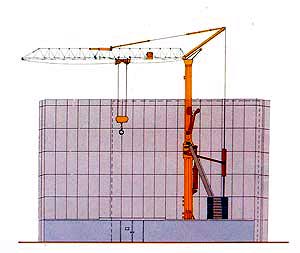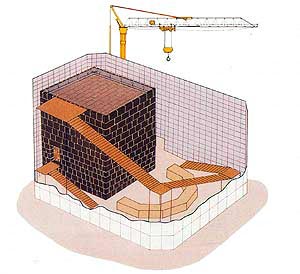 |
>
The Stages of the Construction Work

The wooden wall around the Holy Ka'bah during construction work
A white wooden screen, surrounding the Holy Ka'bah, was the first thing to be erected. The Black Stone, which people touch was left exposed. A space between the Black Stone and the wall of the Holy Ka'bah was left to admit movement and continuity of work. A door leading to the outside of the building itself on the north-western side and another one on he south-western side were opened to allow access and egress. In the first three weeks, all people were allowed to enter into the Holy Ka'bah, itself, through the wooden screen. After prayers, people came in rows to have the honour of entering into the Holy Ka'bah. This process was systematic; a group of people entered while another waited until the first group got out, and so on.
Thus, thousands of people found access to the Holy Ka'bah where they had spiritual moments in the vastness of the Sacred House of Allah. They were also witnesses to the fact that there existed visible cracks that required repairs. This was based on a precedent set by Abdullah Ibn AIZubair (may Allah be pleased with them) who had witnesses who testified that the Holy Ka'bah had to be demolished and rebuilt on the strong foundations of the Sacred House. All the belongings of the Holy Ka'bah were restored to their places alter the renovation had been made. Hands were raised towards Heaven in supplication for those who contributed to the renovation of this sacred building.

A general prespective for the site of the work
- Wall decorations, such as memorial plates and other pieces were removed, cleaned and kept in safety with other belongings, gifts and ornaments of the Holy Ka'bah.
- The first step was to remove the ceiling and the pillars supporting it because it was the part that was subject to the most damage by wood worms, fungi and humidity. The rocky wall was left intact, but the whole ceiling was demolished.
- The plaster covering all the surfaces of the walls of the Holy Ka'bah was removed. Then they dug out and removed the traditional mortar mixture, hoping they would not have to remove the interior stones. On examination, it was discovered that the mixture had lost its cohesiveness due to bacteria, and humidity and this had weakened the stones of the inner body of the wall. It became necessary to remove the stones and reinsert them with mortar better suited to the purpose of the new style of construction.
- It was found that the external wall had no structural defects and that the inner lining was filling the holes as a result of the natural shape and sizes of the rocks in the external wall. It looked like the roots of molars imbedded in the gum. These almost-pointed 'roots' of varying lengths, had gaps between them.
- In general, there were no structural defects in the walls caused by the compression of the soil under the foundations, its rocks or sloping in of the walls.
- The wooden supports on the walls were subject to great damage by white ants, fungi and humidity. This is only natural in buildings that contain wooden materials.
- The work plan was set hl such a way that the renovation of one part should not affect the other, and that the work in the upper part should not affect the lower parts. Work would not shift from one part to the other unless the first one had been completed. Therefore, the implementation of the work took the following three stages:
- The first stage comprised the top four rows of stones.
- The second stage comprised the part below the four rows, down to the level of the internal floor of the Holy Ka'bah.
- The third stage went to the buried part of the level of the internal floor of the Holy Ka'bah up to the present level of the circumambulation area and below it to the depth of 40 to 70 centimeters. In the third stage, the foundation under the level of the circumambulation area was excavated to make sure that it was safe. It was found to be so.
|
 |
